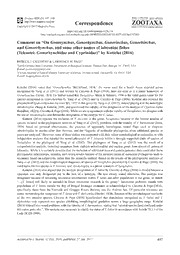
Comment on “On Gonorynchus, Gonorhynchus, Gonorinchus, Gonorhinchus, and Gonorrhynchus, and some other names of labeonine fishes (Teleostei: Gonorhynchidae and Cyprinidae)” by Kottelat (2016) PDF
Preview Comment on “On Gonorynchus, Gonorhynchus, Gonorinchus, Gonorhinchus, and Gonorrhynchus, and some other names of labeonine fishes (Teleostei: Gonorhynchidae and Cyprinidae)” by Kottelat (2016)
Zootaxa 4226 (3): 447–448 ISSN 1175-5326 (print edition) ZOOTAXA http://www.mapress.com/j/zt/ Correspondence Copyright © 2017 Magnolia Press ISSN 1175-5334 (online edition) https://doi.org/10.11646/zootaxa.4226.3.8 http://zoobank.org/urn:lsid:zoobank.org:pub:3854FFF0-03D2-4F5A-8277-43576A717584 Comment on “On Gonorynchus, Gonorhynchus, Gonorinchus, Gonorhinchus, and Gonorrhynchus, and some other names of labeonine fishes (Teleostei: Gonorhynchidae and Cyprinidae)” by Kottelat (2016) PATRICK J. CICCOTTO1 & LAWRENCE M. PAGE2 1North Carolina State University, Department of Biological Sciences, Thomas Hall, Raleigh, NC 27695, USA. E-mail: [email protected] 2Florida Museum of Natural History, University of Florida, Dickinson Hall, Gainesville, FL 32611, USA. E-mail: [email protected] Kottelat (2016) noted that ‘Gonorhynchus McClelland, 1838,’ the name used for a South Asian cyprinid genus recognized by Yang et al. (2012) and revised by Ciccotto & Page (2016), does not exist or is a junior homonym of Gonorhynchus Cuvier, 1816. He further noted that Tariqilabeo Mirza & Saboohi, 1990 is the valid genus name for the species recognized in Gonorhynchus by Yang et al. (2012) and by Ciccotto & Page (2016). Kottelat also rejected the placement of Epalzeorhynchus bicornis Wu, 1977 in this genus by Yang et al. (2012), instead placing it in the monotypic Akrokolioplax Zhang & Kottelat, 2006, and questioned the validity of the designation of the neotype of Cyprinus latius Hamilton, 1822 by Ciccotto & Page (2016). While we are in agreement with the validity of Tariqilabeo, we disagree with the use of Akrokolioplax and defend the designation of the neotype for C. latius. Kottelat (2016) rejected the inclusion of T. bicornis in the genus Tariqilabeo because of the limited number of species included in the phylogenetic analysis of Yang et al. (2012), problems with the identity of T. burmanicus (Hora, 1936) based on personal observations, the presence of apparently homologous rostral flaps used to diagnose Akrokolioplax in species other than bicornis, and the “fugacity of molecular phylogenies when additional species or genes are analyzed.” However, none of these claims was supported with data, either morphological or molecular, or with independent analyses that rejected the nested placement of T. bicornis within a strongly supported clade of species of Tariqilabeo in the phylogeny of Yang et al. (2012). The phylogeny of Yang et al. (2012) was the result of a comprehensive analysis, including sequences from multiple mitochondrial and nuclear genes from almost all genera of labeonins. While it is certainly possible that the inclusion of additional taxa and genetic/genomic data could alter these phylogenetic relationships, rejecting such strong results because of the iterative nature of molecular phylogenies leads to taxonomy based on subjectivity rather than the scientific method. Based on the results of the phylogenetic analyses of Yang et al. (2012) and the morphological diagnoses of species of Tariqilabeo presented by Ciccotto & Page (2016), the valid name for this species is T. bicornis, and Akrokolioplax is a junior synonym of Tariqilabeo. Kottelat (2016) also argued that the neotype designation of T. latius by Ciccotto & Page (2016) is invalid because a specimen was only designated due to the lack of a holotype. The text clearly stated otherwise. The neotype was designated because of remaining taxonomic uncertainties within T. latius and other populations in the genus, as stated: “…[T. latius] will likely be included in future taxonomic research in the group.” Taxonomic problems remain with populations of T. latius outside the Bay of Bengal drainages examined as acknowledged by Ciccotto & Page (2016), specifically those from the Narmada and Ghaggar Rivers draining into the Arabian Sea. Of particular relevance are issues surrounding the recognition of T. latius and T. diplochilus (Heckel, 1838). Because of the morphological similarity of the two putative species, Ciccotto & Page (2016) hypothesized that populations recognized as T. latius and T. diplochilus may represent one species exhibiting morphological gradation across a large geographic range. Kottelat (2016) himself also noted problems with the identity of T. burmanicus, stating that “several species [are] confused under this name; pers. obs.”. The neotype was necessary to clarify the status of T. latius in accordance with Article 75.3.1 of the Code (ICZN 1999). Accepted by J. Sparks: 12 Dec. 2016; published: 27 Jan. 2017 447 References Ciccotto, P.J. & Page, L.M. (2016) Revised diagnosis of the genus Gonorhynchus McClelland (Teleostei: Cyprinidae: Labeonini) with redescription of G. latius (Hamilton) and revalidation of G. wattanah (Sykes). Zootaxa, 4127 (3), 471–492. https://doi.org/10.11646/zootaxa.4127.3.4 ICZN (1999) International Code of Zoological Nomenclature, 4th Edition. The International Trust for Zoological Nomenclature, London, 306 pp. Kottelat, M. (2016) On Gonorynchus, Gonorhynchus, Gonorinchus, Gonorhinchus and Gonorrhynchus, and some other names of labeonine fishes (Teleostei: Gonorynchidae and Cyprinidae). Zootaxa, 4178 (3), 443–450. https://doi.org/10.11646/zootaxa.4178.3.8 Yang, L., Arunachalam, M., Sado, T., Levin, B.A., Golubtsov, A.S., Freyhof, J., Friel, J.P., Chen, W.-J., Hirt, M.V., Manickam, R., Agnew, M.K., Simons, A.M., Saitoh, K., Masaki, M., Mayden, R.L. & Shuping, H. (2012) Molecular phylogeny of the cyprinid tribe Labeonini (Teleostei: Cypriniformes). Molecular Phylogenetics and Evolution, 65, 362–379. https://doi.org/10.1016/j.ympev.2012.06.007 448 · Zootaxa 4226 (3) © 2017 Magnolia Press CICCOTTO & PAGE
